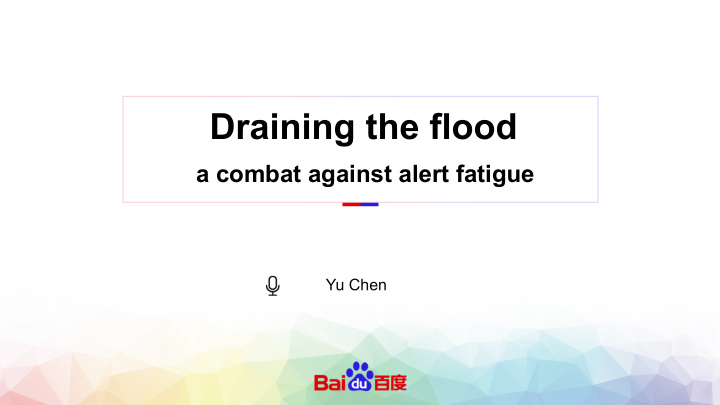



Draining the flood a combat against alert fatigue Yu Chen
The Alert Flood in Baidu • the amount of alerts is high – More than 100 alerts per person per day • Day time: ~75% in 17 hours • Night time: ~25% in 7 hours • Highly Redundant – # effective alerts / # alert SMS < 0.15
Observations & Solutions Observation Reason Solution Duplicate ratio: Persistent alerts Alert grouping • • 58% • Correlated alerts Attention ratio: Over-aggressive alert Alert importance level • • - 25% (at night time) importance Delivery behavior Level calibration • Receivers per alert: • In-effective oncall procedure • Oncall schedule and 3 escalation Single instance alerts: > 40% only requires simple Automatic self-healing • • 88% operations to recover
Alert Grouping • Simple grouping – Remove simple duplicates • Cross-module patterns – Reveal underlying issues • Network connectivity detection – Suppress alert surge
Simple Grouping • Grouping based on natural dimensions – Alert rule name – Deployment structure • Product, Module, Cluster, Instance • Datacenter, machine
Grouping Result {group.ab-zxcvq.AB.all:instance:B_zxcvq_FATAL}{ 总体异常实例比例 :1.36054%}{ 异常 (2):0.opr-zty5-zxcvq-000-cc.AB.bjdc,1.opr-zty5-zxcvq-000-cc.AB.bjdc}{05-02 16:49:36 - 16:54:09} {http://dwz.cn/… } • Rule name – group.ab-zxcvq.AB.all:instance:B_zxcvq_FATAL – Instance level alert • Ratio – 1.36054% • Instance list – 0.opr-zty5-zxcvq-000-cc.AB.bjdc – 1.opr-zty5-zxcvq-000-cc.AB.bjdc • Time – 05-02 16:49:36 - 16:54:09 • Link to detail page – http://dwz.cn/…
Delivery with Grouping Linger Buffer Delivered Alert info Fire time Linger time Alert A: rule1 5 20 A:rule1 A: rule2 10 30 Alert A:rule2 Source B: rule3 20 40 A:rule1 A: rule1 20 20 C: rule4 25 60
Cross-Module Patterns • Caller / Callee A – Both alerts when callee is in trouble • Association rule mining B – Transaction window starting from every alert C:rule3 A:rule1 A:rule3 B:rule2 D:rule4 B:rule2 A:rule1, B:rule2, C:rule3 B:rule2, C:rule3, D:rule4 M:ruleX à N:ruleY …… C:rule3, B:rule2
Network Connectivity • Network device failure can caused a lot of alerts • Should trigger alerts for – Most rules – Most products • Heuristic rule
Linger Time • Configurable – Different among alert rules • Extra delay to receive alerts – Less punctual • Need better ways to balance
Attention Ratio • Check existence in interval – Access log of the monitoring system • View alert detail • View relevant curves – Login log of the production machine • Exist: alert is attended • Absent: alert is ignored • Only applied to night time
Alert Calibration • Importance levels – Critical: SMS + Phone to all receivers – Major: SMS + Escalation – Warning: SMS without Escalation – Notice: Mail • Attention ratio should be compatible to levels – Push from mangers
Alert Receivers • Typical receivers of an alert – Primary oncall engineer – Secondary oncall engineer – Oncall engineer lead – Senior engineer – Manager • Primary oncall engineer handles alerts usually – But alerts always sent to all
Oncall Escalation • Alerting stages – One fixed stage • primary, secondary – Zero or more escalation stages a minutes b minutes Primary Escalation1 (Secondary)
Oncall Escalation Oncall schedule Fixed stage Escalation stage
Automatic Self-healing • Lazy log purge – Set an alert on disk free space – Delete some log when alert triggers • Granularity – Instance level • “bin_control restart” – Module/Cluster level • “curl master.a.com” • Alert – will not deliver – view alert log
Management Support • Alert importance calibration – Lower importance level • Oncall escalation – Include attention ratio into work evaluation
Decrease by 85% Number of Alerts / Weekly Total DayTime Night
Remarks • Reducing redundant alerts – Mining alert correlation for grouping – Estimate attention ratio for importance calibration – Receiver escalation mechanism – Alert self-healing mechanism • Helpful on understanding root causes of issues
chenyu07@baidu.com
Recommend
More recommend